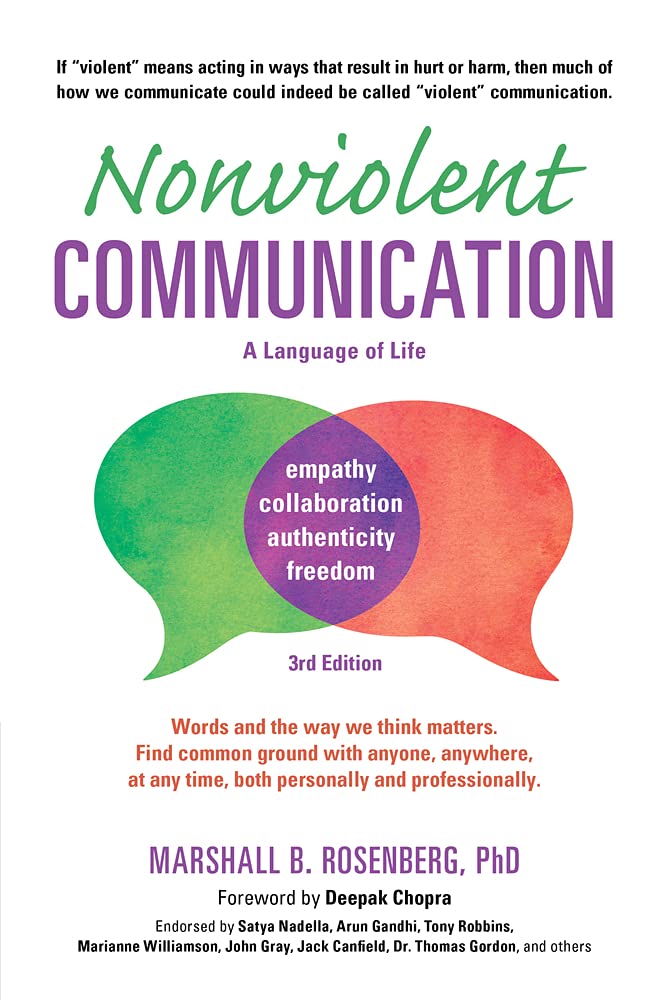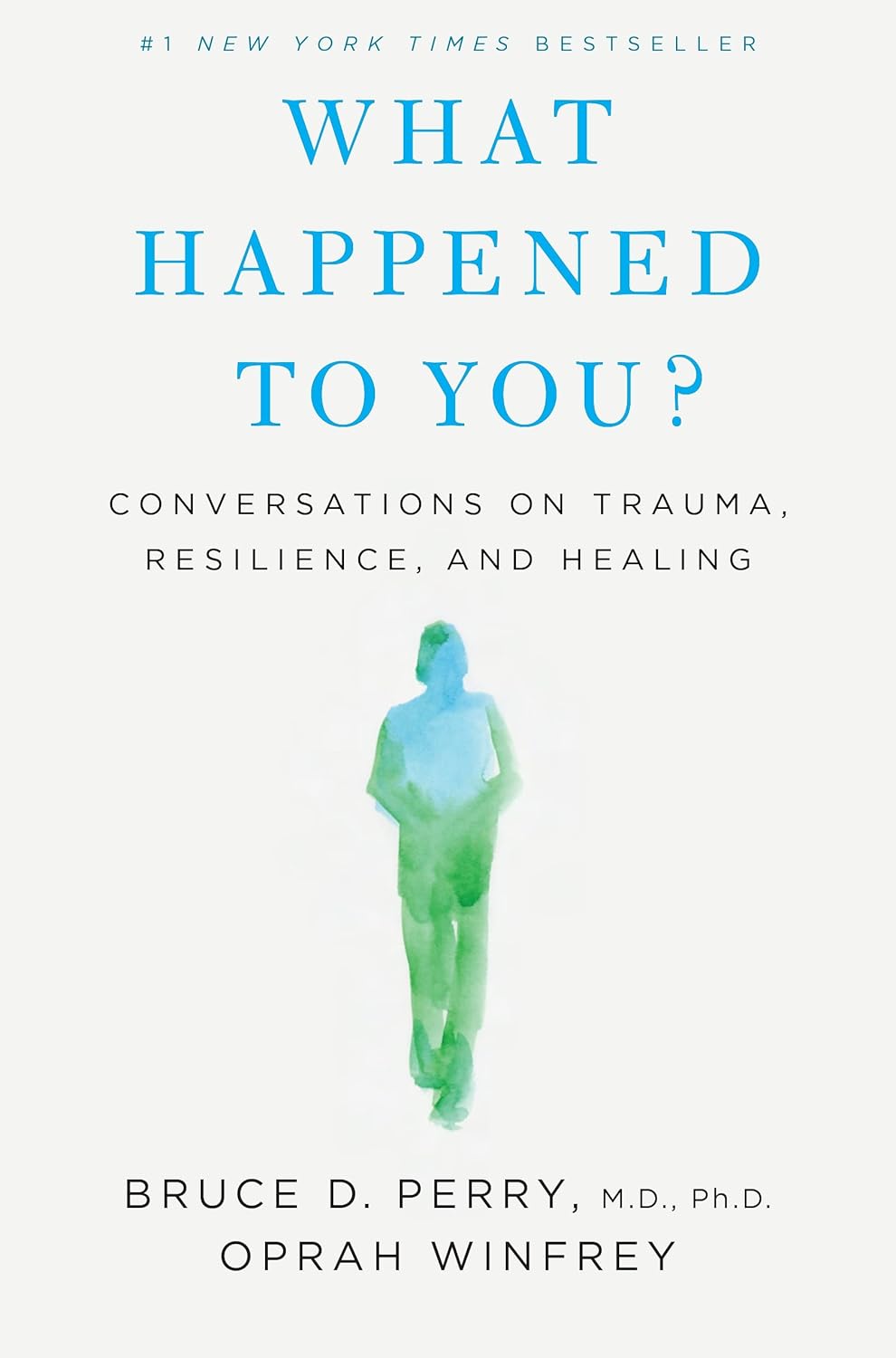
Buy The Book
Chapter
- ✦ Chapter 1: Giving From the Heart
- ✦ Chapter 2: Communication That Blocks Compassion
- ✦ Chapter 3: Observing Without Evaluating
- ✦ Chapter 4: Identifying and Expressing Feelings
- ✦ Chapter 5: Taking Responsibility for Our Feelings
- ✦ Chapter 6: Requesting That Which Would Enrich Life
- ✦ Chapter 7: Receiving Empathically
- ✦ Chapter 8: The Power of Empathy
- ✦ Chapter 9: Connecting Compassionately with Ourselves
- ✦ Chapter 10: Expressing Anger Fully
- ✦ Chapter 11: The Protective Use of Force
- ✦ Chapter 12: Liberating Ourselves and Counseling Others
- ✦ Chapter 13: Expressing Appreciation in Nonviolent Communication
Nonviolent Communication: A Language of Life

About
“Nonviolent Communication: A Language of Life” by Marshall Rosenberg offers a transformative approach to communication rooted in empathy and compassion. Rosenberg, an American psychologist, introduces Nonviolent Communication (NVC) as a method to foster connection and resolve conflict peacefully.
NVC focuses on four key components: observations, feelings, needs, and requests. It teaches individuals to express themselves honestly by articulating their observations without judgment, identifying and acknowledging their feelings, connecting those feelings to unmet needs, and making clear, specific requests. Simultaneously, NVC emphasizes empathetic listening, encouraging individuals to understand others’ observations, feelings, needs, and requests. By prioritizing empathy and clear expression, NVC promotes understanding, reduces conflict, and encourages compassionate connections in personal, professional, and global settings. Ultimately, Rosenberg presents NVC as a tool for creating a more peaceful and harmonious world.

Spark
Learn
Review
✦ Chapter 1: Giving From the Heart
Compassion, the natural state of humanity, thrives on giving and receiving from the heart. Disconnection from this state leads to violence and exploitation, prompting the crucial question: What enables some to maintain compassion even in dire circumstances?
Nonviolent Communication (NVC) offers a path to connect with ourselves and others, fostering compassion. It reminds us of our innate relational capacity and helps us embody it. By reshaping expression and reception, NVC transforms automatic reactions into conscious responses rooted in awareness of perceptions, feelings, and desires. Honesty and clarity in expression intertwine with respectful and empathic attention. Exchanges reveal deeper needs, promoting careful observation and articulation of affecting behaviors and conditions, alongside clear specification of desired outcomes. This simple yet potent method replaces defense mechanisms with a new understanding of ourselves, others, intentions, and relationships, minimizing resistance and violent reactions.
Clarifying observations, feelings, and needs, rather than judging, unveils profound compassion. Emphasis on deep listening cultivates respect, attentiveness, and empathy, inspiring a mutual desire to give from the heart. NVC serves as a constant reminder to focus on achieving goals, facilitating compassion expressed through willingly enriching others’ lives. This benefits both giver and receiver, with the receiver enjoying the gift without fear and the giver experiencing enhanced self-esteem. NVC’s principles, driven by the motive to give and receive compassionately, invite others to join, fostering inevitable compassion. Focusing on observation, feeling, needs, and requests, establishes communication until compassion naturally arises.
✦ Chapter 2: Communication That Blocks Compassion
Certain communication styles can block compassion, leading to misunderstandings and hindering connection. These patterns, often ingrained in our language and thought, can create distance and prevent us from seeing each other’s humanity.
Moralistic judgments, a common barrier, involve implying wrongness or badness in others who don’t act according to our values. Such judgments provoke defensiveness and resistance, obscuring our own needs and feelings. Instead of stating what we need, we criticize others for their actions. Making comparisons is another form of judgment, fostering competition and diminishing appreciation for uniqueness. By focusing on who is “better” or “worse,” we miss the opportunity to connect with others on a deeper level.
Denial of responsibility further obstructs compassion. When we attribute our actions to external factors, we avoid taking ownership of our choices and their impact. Phrases like “I had to” or “I was made to” shift blame and prevent genuine connection. Accepting responsibility involves acknowledging our role in creating our experiences.
Another obstacle is the use of demands, which explicitly or implicitly threaten punishment for non-compliance. Demands create fear and resentment, making it difficult for others to respond with compassion. When we make requests instead of demands, we invite cooperation and foster a sense of partnership.
These communication patterns share a common thread: they obscure our awareness of what’s truly alive in us and in others. They limit our ability to see each other as human beings with needs, feelings, and values. By recognizing and challenging these patterns, we can open ourselves to more compassionate and fulfilling connections.
Replacing these habits requires conscious effort. We must learn to observe without judging, identify and express our feelings, connect our feelings to unmet needs, and make clear, specific requests. This shift in communication fosters empathy, understanding, and a willingness to give from the heart. When we communicate in a way that honors our own humanity and the humanity of others, we create a space for compassion to flourish. Through this practice, we can move beyond defensiveness and create genuine connection. Ultimately, this approach invites collaboration and shared solutions. This facilitates a path to a more compassionate and harmonious existence.
✦ Chapter 3: Observing Without Evaluating
The first aspect of Nonviolent Communication (NVC) involves distinguishing observation from evaluation. It’s crucial to observe clearly what we’re seeing, hearing, or touching that affects our well-being, all without blending in any assessments.
Observations hold significant importance in NVC, particularly when we aim to articulate our feelings honestly to others. However, when we merge observation with evaluation, we diminish the likelihood of our intended message being heard. Instead, individuals tend to perceive criticism, triggering resistance to what we’re expressing. NVC doesn’t prohibit objectivity or evaluation; it simply necessitates maintaining a distinction between the two. NVC employs a dynamic language that discourages rigid generalizations, grounding assessments in specific observations tied to time and context.
Semanticist Wendell Johnson highlighted how static language can create problems by attempting to capture an ever-changing reality. This mismatch between our dynamic world and static language contributes to our difficulties. A colleague, Ruth Bebermeyer, illustrates this contrast between static and process language in a song, showcasing the divergence between evaluation and observation.
Indian philosopher J. Krishnamurti once noted that observing without evaluating represents the highest form of human intelligence. It’s challenging for many to observe people and their behaviors without judgment or criticism.
Working with an elementary school revealed communication challenges stemming from staff evaluations of the principal. Initial responses lacked specific behavioral descriptions, hindering clear communication. By collaborating to create a list of specific, non-evaluative behaviors, the staff was able to address concerns effectively. Eventually, teachers clarified the principal’s actions, leading to his acknowledgment and a collaborative effort to address the issue, emphasizing the power of clear, non-evaluative observations.
✦ Chapter 4: Identifying and Expressing Feelings
Expressing feelings forms a core component of Nonviolent Communication (NVC). While mature individuals possess a nuanced emotional vocabulary, many struggle to articulate their feelings clearly. Formal education often prioritizes “correct” thinking over emotional awareness, fostering a disconnect from inner experiences.
Statements that begin with “I feel like…” often express opinions or judgments rather than genuine emotions. For instance, “I feel like I’m married to a wall” conveys criticism rather than vulnerability. Strengthening one’s emotional vocabulary proves beneficial in both personal and professional spheres. By expressing humanity openly, individuals can improve their communication and foster deeper connections.
Hiding feelings can hinder connection. Even in professional settings, vulnerability can be transformative. It’s crucial to distinguish descriptions of perceived states from actual emotions, such as understanding the difference between saying “I feel inadequate” versus “I feel disappointed.” It’s also important to articulate personal feelings rather than simply describing another’s actions. For example, “I feel ignored” reflects interpretation, while “I feel hurt” expresses emotion.
Developing a broader vocabulary enables accurate communication. Vague words such as “good” prevent listeners from connecting with true emotions. Using precise language to describe a range of emotional experiences promotes clear expression and fosters more compassionate connections. Accurately identifying and expressing feelings is a skill that can be cultivated for more effective and meaningful communication.
✦ Chapter 5: Taking Responsibility for Our Feelings
Feelings result from how we choose to receive what others say and do, and is not caused by others. It results from whether or not we are choosing to take care of our needs. Taking responsibility for our feelings distinguishes NVC from ways of communicating where it is assumed that others are responsible for what we feel.
When someone communicates negatively, we have four options:
1. Blame ourselves.
2. Blame others.
3. Sense our own feelings and needs.
4. Sense the other person’s feelings and needs.
Taking responsibility of our feelings, we can express three parts:
1. Observation
2. Feeling
3. Need
For example, rather than saying “You make me angry,” we can say, “When you do X, I feel Y because I need Z.” Recognizing the needs at the root of our feelings allows us to move beyond blame and connect with each other on a deeper level.
It’s liberating to recognize we are not slaves to our feelings. Initially, feeling responsible for our feelings may seem daunting, but it leads to emotional liberation. We can acknowledge what we are feeling, what we are needing, and what we are wanting, rather than blaming others for our pain. This freedom empowers us to choose how we respond to situations and to take proactive steps to meet our needs.
✦ Chapter 6: Requesting That Which Would Enrich Life
The fourth component of NVC addresses requests made consciously, specifying desired actions for enriching life. Having articulated observations, feelings, and needs, a request clarifies what we want from others.
Requests use positive action language, stating what we desire rather than what we don’t. This enhances clarity, especially when addressing groups. When communicating requests, uncertainty can arise if we aren’t clear about what response we want. People may not know if we want honesty, empathy, or simply for them to take action. To avoid confusion, it is important to indicate the type of response desired.
Asking for a reflection ensures our message is understood. By inviting the other person to paraphrase our words, we confirm they’ve grasped our meaning and feelings. Alternatively, we might ask them to share their understanding of what we’re needing.
Distinguishing requests from demands is essential. A request acknowledges the other person’s right to refuse, without impacting our affection. Conversely, demands imply blame or punishment for non-compliance. Clarifying objectives when making requests avoids misunderstandings and fosters connection. By expressing observations, feelings, needs, and clear requests, we increase the likelihood of compassionate and effective communication, facilitating mutual understanding and enriching everyone’s lives.
✦ Chapter 7: Receiving Empathically
Empathy involves emptying the mind and listening with the whole being. Presence is vital; avoid doing anything, just be there. Empathizing requires focusing on feelings and needs.
When someone shares, listen for the feelings and needs, whether explicitly stated or implied. People express themselves in various ways; empathize without fixating on the form. Even cynical remarks reveal underlying pain. Translate judgmental language into expressed feelings and unmet needs. For example, “That’s a ridiculous proposal” could mean they feel concerned and need efficiency.
Paraphrasing is crucial for empathy. Reflect what another said by rephrasing. This confirms understanding or allows clarification. Paraphrase to ensure you grasp their meaning, but don’t parrot; use your own words. Confirm both content and feelings.
Sustaining empathy can be challenging. Be patient; people need time to fully express themselves. Interrupting hinders the process. Resist urges to offer advice or share personal stories. Empathy requires being fully present with the other person’s experience before shifting focus.
Sometimes, personal pain hinders empathy. Recognize your limits. If unable to empathize, acknowledge your difficulty and seek support before continuing. This honesty respects both parties and preserves connection. Empathy fosters understanding and connection, essential for compassionate communication.
✦ Chapter 8: The Power of Empathy
Empathy illuminates what’s happening within another person, easing suffering. With NVC, empathy means connecting to the other person’s feelings and needs, without any judgment.
When dealing with intense verbal attacks, empathy can neutralize the situation, allowing you to understand the other’s pain. Listen intently, seeking to understand their feelings and needs. Asking questions can guide you, but the core lies in your genuine presence.
Empathy extends to hearing “no.” Instead of taking it as rejection, explore the underlying reasons. The person might be expressing needs for autonomy, rest, or understanding. Listen for these needs to discover the deeper message.
Conversations can lose life. Empathy can rekindle them. Acknowledge the other person’s perspective and feelings. Even when faced with silence, empathy is useful. The person may need time to process emotions or may struggle expressing themselves.
By staying connected to their feelings and needs, you provide space for them to open up. It’s important to offer empathy, not sympathy. Sympathy involves pity, while empathy seeks understanding. Empathy fosters connection and healing by acknowledging the shared human experience. This understanding has the power to transform painful interactions into moments of genuine connection.
✦ Chapter 9: Connecting Compassionately with Ourselves
Compassionately connecting with ourselves starts with remembering the specialness of what we are. Often, we evaluate ourselves when we’ve been less than perfect. It’s key to translate self-judgments and inner demands into needs.
NVC mourning involves connecting with the unmet needs behind our pain, enabling self-forgiveness. The lesson of the polka-dotted suit teaches us not to do anything that isn’t play. We can translate “have-to’s” to “choose-to’s,” cultivating awareness of the energy behind our actions.
Replace self-criticism with understanding unmet needs. Internalizing NVC means recognizing that self-judgments are disconnected expressions of needs. By acknowledging needs for celebration, mourning, or self-forgiveness, we connect with the core of our humanity. This process helps us transform “shoulds” and “musts” into conscious choices aligned with values. Recognizing choices frees us from resentment and enlivens our actions with purpose.
NVC invites a shift towards self-compassion, understanding that unmet needs drive negative self-talk. Instead of self-blame, focus on acknowledging and addressing these needs. Embrace choices rooted in self-awareness and values. This internal shift is powerful, fostering a positive relationship with ourselves. Ultimately, this compassionate connection enhances our well-being.
✦ Chapter 10: Expressing Anger Fully
Anger stems from unmet needs, not from others’ actions. The key is to shift focus inward. Instead of blaming, identify the unmet needs that fuel the anger.
To fully express anger, follow four steps: stop and breathe, identify judgmental thoughts, connect with unmet needs, and express feelings and unmet needs. Initial reactions often involve blaming others. Recognize these thoughts without acting on them; translate judgments into feelings and unmet needs. For instance, “They shouldn’t do that!” becomes awareness of feeling frustrated because needing respect.
Expressing anger nonviolently means sharing feelings and unmet needs, not blame or judgment. “I feel angry because needing consideration” is a constructive expression. Suppressing anger harms relationships and well-being. Expressing it through blame only escalates conflict. By connecting with unmet needs and expressing them vulnerably, anger transforms into a catalyst for understanding and connection.
This approach helps others understand our experience and promotes genuine connection. Transforming judgments into feelings and needs fosters empathy and understanding. Ultimately, NVC offers a pathway to express anger fully and authentically, facilitating personal well-being and strengthening relationships through honest, compassionate communication. It facilitates deeper connections.
✦ Chapter 11: The Protective Use of Force
Force is sometimes unavoidable, but when used, it must always be protective and never punitive. The key lies in the intent behind its application.
Punitive force is driven by a desire to make others suffer for their actions, viewing punishment as a way to inflict pain as a consequence. Protective force, in contrast, focuses on preventing immediate harm, injury, or injustice. Though often disguised as “justice,” punishment perpetuates cycles of violence and fails to address the root causes of behavior. The goal of protective force is to deter harmful behavior, not to inflict suffering.
Punishment carries significant costs. It breeds resentment, hostility, and a desire for revenge, obscuring the underlying reasons for the actions in question. It also diminishes self-esteem and fails to teach compassionate behavior. The limitations of punishment become clear when asking: What behavior do we want to encourage instead? What reasons do we want the person to have for choosing that behavior?
While protective force can be necessary in settings like schools, it demands conscious awareness. It is about safeguarding children from harm, not controlling them through fear or intimidation. It’s essential to address the underlying needs driving a child’s behavior and create a safe, supportive, and nurturing learning environment. When protective force becomes necessary, it must be used in conjunction with clear, respectful communication, empathy, and a commitment to finding solutions that meet everyone’s needs. Ultimately, the goal is to foster understanding, connection, and compassion, even in the most challenging situations. This approach emphasizes mindful awareness and a commitment to safeguarding the well-being of all involved. It prioritizes long-term solutions.
✦ Chapter 12: Liberating Ourselves and Counseling Others
NVC supports personal liberation by helping us recognize and respond to the beauty within ourselves and others. The first step is often recognizing old programming, the ingrained thoughts and beliefs that limit our choices and perpetuate suffering. By becoming aware of these patterns, we can begin to free ourselves from their grip.
Internal conflicts can also hinder liberation. NVC provides tools to understand and resolve these conflicts by connecting with the underlying needs driving each conflicting voice within us. This involves identifying the feelings and needs associated with each side of the conflict, fostering inner harmony, and aligning actions with core values.
Caring for our inner environment is vital for maintaining compassion. Regularly attending to our feelings and needs, especially during challenging times, strengthens our capacity for empathy and connection. This self-care is not selfish, but essential for sustaining our ability to offer compassion to others.
NVC offers a powerful alternative to traditional diagnostic approaches. By focusing on observations, feelings, needs, and requests, we move beyond labeling and judging others, fostering understanding and promoting collaborative solutions. This shift empowers individuals to connect authentically, fostering healing and growth for both themselves and others.
✦ Chapter 13: Expressing Appreciation in Nonviolent Communication
Appreciation shines when expressing genuine gratitude, not manipulating others. The intent behind appreciation matters most. What motivates expression: honest gratitude or a desire for something in return?
Appreciation involves three components:
1. Actions contributing to well-being.
2. Needs fulfilled.
3. Pleasurable feelings aroused.
For instance, saying, “Seeing you studied hard (action), helped me feel secure (feeling) because needing support (need),” expresses genuine appreciation. This differs from flattery that is often vague.
Receiving appreciation can feel awkward. Common reactions include dismissal or self-deprecation. Resisting appreciation blocks the giver’s joy. NVC suggests receiving appreciations by internalizing the giver’s words, acknowledging the impact of one’s actions. Simply hear the three components: action, need, and feeling.
A hunger for appreciation exists, but expressing it feels difficult. By focusing on the three components, appreciation becomes easier and more authentic, strengthening connections and enriching lives. Gratitude, when expressed genuinely, fosters joy and deepens relationships.
For People
– Parents
– Educators
– Managers
– Mediators
– Anyone seeking improved relationships
Learn to
– Enhanced empathy
– Improved communication skills
– Peaceful conflict resolution
– Increased self-awareness
– Stronger relationships









